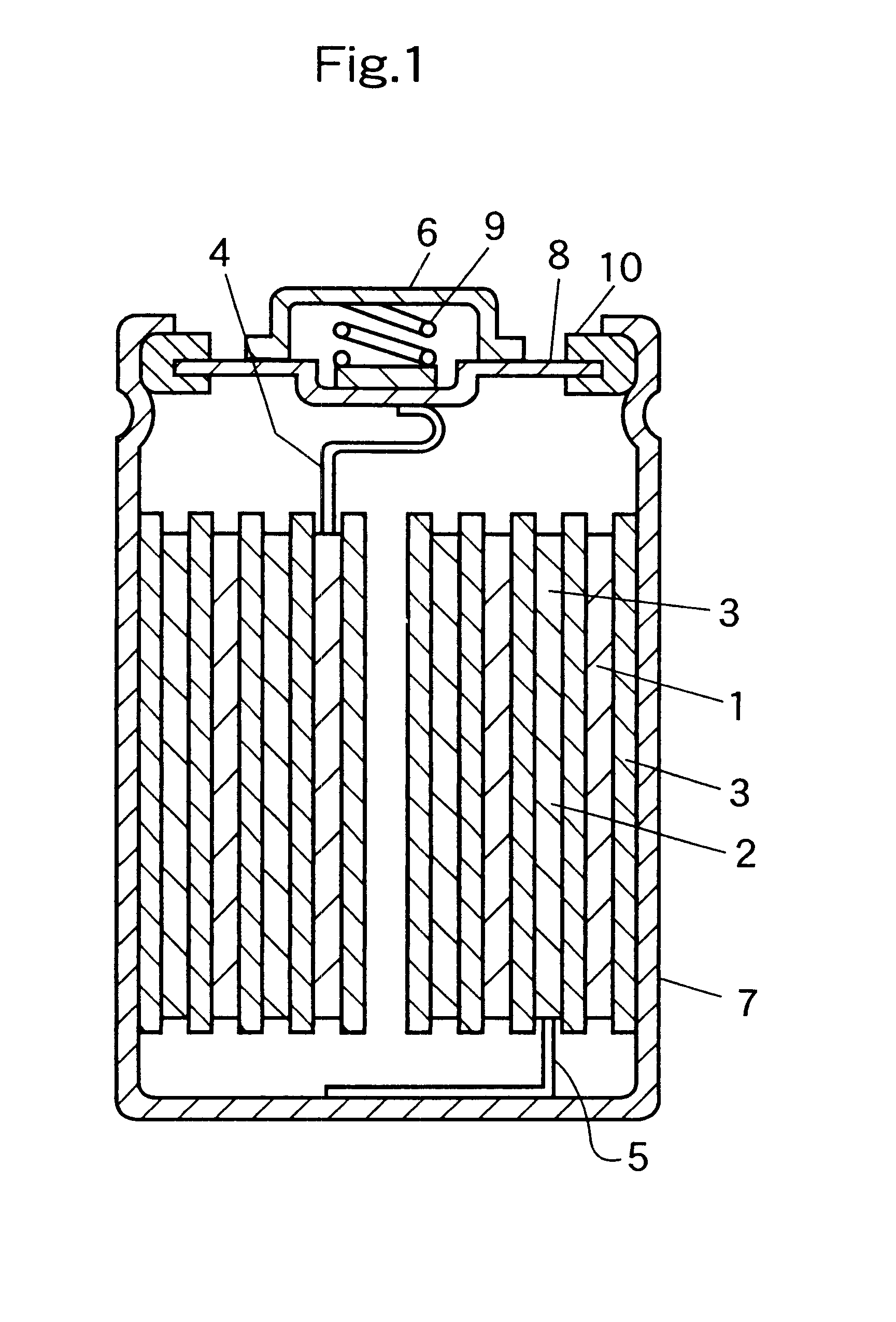Hydrogen storage alloy electrode and method for fabrication thereof
- Summary
- Abstract
- Description
- Claims
- Application Information
AI Technical Summary
Benefits of technology
Problems solved by technology
Method used
Image
Examples
experiment 1
Experiment 1 was conducted to investigate the effect of the agglomerate content of the hydrogen storage alloy powder on the operational characteristics of a battery.
(a) Formation of an MmNi.sub.3.1 Co.sub.0.8 Al.sub.0.4 Mn.sub.0.7 Alloy
A misch metal (Mm) was prepared containing 25 wt % of lanthanum (La), 50 wt % of cerium (Ce), 6 wt. % of praseodymium (Pr) and 19 wt. % of neodymium (Nd). The misch metal prepared was then mixed with a group of 99.9% pure metals, i.e., with nickel (Ni), cobalt (Co), aluminum (Al) and manganese (Mn) in the ratio of Mm:Ni:Co:Al:Mn=1.0:3.1:0.8:0.4:0.7 (molar ratio). The mixture was melted in an electric-arc melting furnace under an argon atmosphere and subsequently allowed to cool naturally, so that a hydrogen storage alloy represented by the formula MmNi.sub.3.1 Co.sub.0.8 Al.sub.0.4 Mn.sub.0.7 was formed. An ingot of the hydrogen storage alloy thus formed was then mechanically pulverized in the air into particles which were subsequently subjected to si...
experiment 2
Experiment 2 was conducted to make investigations on the type of the metallic compound for use in the formation of the metallic layer for joining the hydrogen storage alloy particles.
Cobalt chloride (CoCl.sub.2), copper chloride (CuCl.sub.2), palladium chloride (PdCl.sub.2) or silver chloride (AgCl) was added to an aqueous solution of hydrochloric acid (acid solution) in the amount of 3.0 parts by weight, based on 100 parts by weight of the alloy powder #1. Each mixture was adjusted to pH 1.0 to prepare a treating solution. The alloy powder #1 was immersed with agitation in each treating solution maintained at 25.degree. C. for the duration of 15 minutes. A sequence of suction filtration, rinsing with water and drying was followed. As a result, sample powders "B-1" through "B-4" were obtained.
Each sample powder obtained was subjected to sieving with a 500-mesh screen to weigh the alloy particles of sizes not exceeding 25 .mu.m which passed through the screen openings. Prior to being...
experiment 3
Experiment 3 was conducted to investigate the dependence of battery performance on concentrations of the metallic compound in the acid solution. The additive compound used was silver chloride (AgCl).
Silver chloride was added to an aqueous solution of hydrochloric acid in the amount, by weight, of 0.5 parts, 1.0 part, 3.0 parts, 5.0 parts, 7.0 parts, 10.0 parts and 15.0 parts, based on 100 parts by weight of the alloy powder #1 to be treated. Each mixture was adjusted to pH 1.0 to prepare a treating solution. The alloy powder #1 was immersed with agitation in each treating solution maintained at 25.degree. C. for the duration of 15 minutes. A sequence of suction filtration, rinsing with water and drying was followed. As a result, sample powders "C-1" through "C-7" were obtained.
As analogous to the above-described Experiment 1, each of the sample powders C-1 through C-7 thus prepared was used to fabricate a hydrogen storage alloy electrode for subsequent assembly into an alkaline stor...
PUM
 Login to View More
Login to View More Abstract
Description
Claims
Application Information
 Login to View More
Login to View More - R&D
- Intellectual Property
- Life Sciences
- Materials
- Tech Scout
- Unparalleled Data Quality
- Higher Quality Content
- 60% Fewer Hallucinations
Browse by: Latest US Patents, China's latest patents, Technical Efficacy Thesaurus, Application Domain, Technology Topic, Popular Technical Reports.
© 2025 PatSnap. All rights reserved.Legal|Privacy policy|Modern Slavery Act Transparency Statement|Sitemap|About US| Contact US: help@patsnap.com

